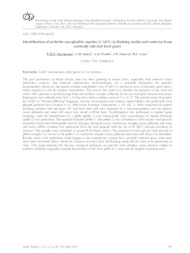Identification of arthritis encephalitis caprine (CAEV) in flushing media and embryos fromnaturally infected herd goats.
Identification of arthritis encephalitis caprine (CAEV) in flushing media and embryos fromnaturally infected herd goats.
Author(s): NASCIMENTO, P. M. P.; SANTOS, G. B.; PENIDO, A. O.; FONSECA, J. F. da; LEITE, R. C.
Summary: Abstract: The goat production in Minas Gerais state has been growing in recent years, especially with intensive dairy production systems. The artificial reproduction biotechnologies are a powerful mechanism for genetics dissemination. However, the caprine arthritis encephalitis virus (CAEV) is present in most of the dairy goats farms, which represent a risk for disease transmission. The aim of this study is to identify the presence of pro-viral and viral CAEV genome in uterine lavage fluid and embryos samples collected by the non cirurgical transcervical assay. Eight goats were selected with 56.0 ± 13,4kg and a body condition score of 3.5 ± 0.75. The animals were all positive for CAEV in "Western Blotting" diagnosis. Oestrus sycronisation and ovarian superovulation was performed from adapted protocol from Fonseca et al, 2006 (Acta Scientiae Veterinariae, v. 34, sul. 1). After transcervical embryo flushing, embryos that had intact ZP, had their inner cell mass aspirated by a micromanipulator, and the product (zona pellucida and inner cell mass) was stored in RNA later. Centrifugation was performed in uterine liquid washings, until the identification of a pellet (pellet 1) and subsequently viral concentration of uterine flushings (pellet 2) was performed. The material obtained (pellets 1 and pellets 2) was submitted to viral and pro-viral genome extraction with Cador Pathogen® mini kit (Qiagen, Germany) assay. Embryonic samples (zona pellucida and inner cell mass) cDNA synthesis was performed from the viral genome with the use of M MLV enzyme according to protocol. The samples were submitted to nested PCR (Fieni, 2010,). The presence of viral and pro-viral genome in pellet (samples 2), but not in the pellet 1 or embryonic samples (zona pellucida and inner cell mass) was identified. Results shows viral replication could happen in the reproductive system from naturally infected goats, what have never been described before. However, embryos recovery from the flushing media did not show to be permissive to virus. This might indicate that the non cirurgical technique can provide virus dilution, since previous studies in embryos collected surgically revealed the presence of the virus pellet in 1, what did not happen in present work.
Publication year: 2015
Types of publication: Abstract in annals or event proceedings
Unit: Embrapa Goats & Sheep
Keywords: Animal biotechnology, Animal diseases, Artrite encefalite caprina, Biotecnologia, CAEV, Caprine arthritis encephalit virus, Caprino, Disease transmission, Doença animal, Embryo transfer, Goat diseases, Goats, In vivo embryos, Reprodução animal, Transferência de embrião, Transmissão de doença
Observation
Some of Embrapa's publications are published as ePub files. To read them, use or download one of the following free software options to your computer or mobile device. Android: Google Play Books; IOS: iBooks; Windows and Linux: Calibre.
Access other publications
Access the Agricultural Research Database (BDPA) to consult Embrapa's full library collection and records.
Visit Embrapa Bookstore to purchase books and other publications sold by Embrapa.

